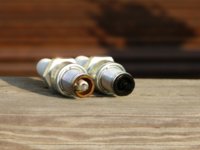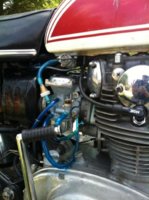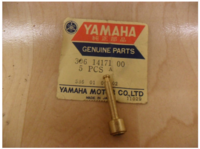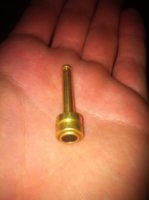1972 XS2 with 19,000 showing. Bought it in parts and put it together.
1972 BS38 Donor Carbs from an upstanding forum member. 130 Mains 42.5 Pilots Floats set at 25mm. Mix screws are both set 3/4 turn out. Dead cylinder method. Stock airboxes and new filters.
Pamco w/ Hight Output Coil & E Advance.
B8ES plugs gapped to .035"
Cam chain set.
Intake set @ .006" & Exhaust set @ .012"
Compression test Cold: RH 122 LH 118
Compression test Hot: RH 110 LH 110
Starts first kick or bump of the e start, hot or cold.
I cleaned up the carbs when I got them. Both plugs looked very rich (like the plug on the right in the image). I took them to a local very experienced with vintage metrics and let him go through them. Put them back on and the LH plug still looks the same. RH plug looks completely different now. I took a trip back over to the locals shop and showed him the plugs. He says the RH plug looks perfect. I was worried it might be a bit lean. He said it was probably a motor related issue since the bike was an orphan with no known history. He asked me to swap the carbs to the opposite cylinders and see what happens. He was sure it would stay in the same cylinder. I swapped the carbs to the opposite cylinders. Installed new plugs. LH carb on RH cylinder produced the same black plug. RH carb on LH cylinder produced the same whitish plug with a bit of tan down near the base of the insulator. Swapped the carbs back to their appropriate cylinders and the rich plug followed the LH carb. Is a clogged air jet(s) in the LH carb causing this or something else?
Here is a picture of the plugs for a visual. Black is sooty and not wet at all. Let me know what you think. Thanks in advance!
1972 BS38 Donor Carbs from an upstanding forum member. 130 Mains 42.5 Pilots Floats set at 25mm. Mix screws are both set 3/4 turn out. Dead cylinder method. Stock airboxes and new filters.
Pamco w/ Hight Output Coil & E Advance.
B8ES plugs gapped to .035"
Cam chain set.
Intake set @ .006" & Exhaust set @ .012"
Compression test Cold: RH 122 LH 118
Compression test Hot: RH 110 LH 110
Starts first kick or bump of the e start, hot or cold.
I cleaned up the carbs when I got them. Both plugs looked very rich (like the plug on the right in the image). I took them to a local very experienced with vintage metrics and let him go through them. Put them back on and the LH plug still looks the same. RH plug looks completely different now. I took a trip back over to the locals shop and showed him the plugs. He says the RH plug looks perfect. I was worried it might be a bit lean. He said it was probably a motor related issue since the bike was an orphan with no known history. He asked me to swap the carbs to the opposite cylinders and see what happens. He was sure it would stay in the same cylinder. I swapped the carbs to the opposite cylinders. Installed new plugs. LH carb on RH cylinder produced the same black plug. RH carb on LH cylinder produced the same whitish plug with a bit of tan down near the base of the insulator. Swapped the carbs back to their appropriate cylinders and the rich plug followed the LH carb. Is a clogged air jet(s) in the LH carb causing this or something else?
Here is a picture of the plugs for a visual. Black is sooty and not wet at all. Let me know what you think. Thanks in advance!
Attachments
Last edited:









